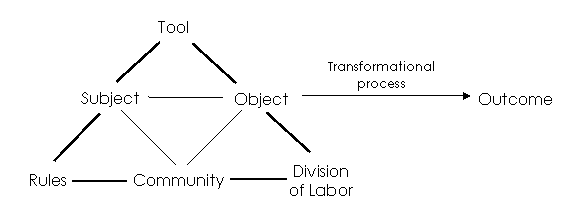| Activity Theory is a framework that provides some insight into issues around how people use tools. This is a small summary of some of its ideas. |
Introduction
On the agile-usability list, Larry Constantine brought up the notion of Activity Theory as a framework for some aspects of HCI. That prompted me to explore the topic a little. This note is a summary of the terms and key ideas of the paper “Activity Theory,” by Tyler Waite. Any misunderstandings are certainly mine.
Key Ideas
Activity – a high-level motivating concept. For example, fixing dinner.
Action – something to accomplish a specific goal. For example, making a salad. The effects of an action are not fully predictable (they may have to deal with exceptional situations). After performing an action, someone will assess the situation to decide if the goal has been achieved.
Operation – behaviors not requiring conscious effort. For example, slicing a carrot. They involve automatic responses to a perceived state.
Activities consist of many actions. Actions consist of many operations.
Key principle: [Over time, and with practice,] activities may become actions (e.g., if they’re part of a larger activity), and actions can become operations.
Waite gives the example of learning to write. At first, even drawing a letter is an activity. As the writer improves, it becomes an action, and eventually an operation.
(I’m also reminded of Kano’s model: something starts out as a delighter (unexpected but delightful when found), then becomes a satisfier (normal feature, more is better), then a dissatisfier (if you don’t have it, you’re not even in the game).)
Community – activities have a social component; they don’t just affect one individual. A primary role of the community is to create rules.
Rule – inform individual of desired outcome; inform individual about the object that is the focus of the activity; instruct the individual on how to work on an object.
An individual decides which rules to follow, applies them, and revises/adds rules. Rules can be illuminative (provide a way to view the problem) and restrictive (prevent alternative approaches).
Tool – can be physical artifacts, ideas, theoretical frameworks, etc.
Object – can be physical or mental/abstract.
Engestom’s Model of Activity Theory: (as shown by Waite)

[Written 1/21/2007.]